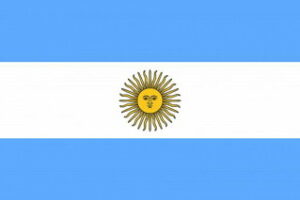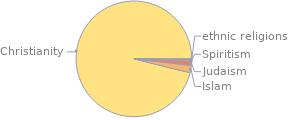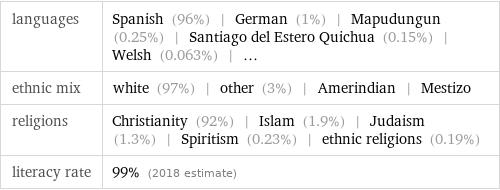South America
Argentina



Argentina People Groups from The Joshua Project
Argentina. Data from The Joshua Project (https://www.joshuaproject.net)
| People | Reached | Language | Population | Bible | Religion | Adherents | Evangelical |
|---|---|---|---|---|---|---|---|
| Jew Spanish-speaking | Unreached | Spanish |
175,000 |
Complete Bible | Ethnic Religions |
0.2 |
0.2 |
| Turk | Unreached | Turkish |
800 |
Complete Bible | Islam |
0.0 |
0.0 |
| Arab Palestinian | Minimally Reached | Arabic-South Levantine Spoken |
1,200 |
Portions Completed | Islam |
32.0 |
2.0 |
| Arab Syrian | Minimally Reached | Arabic-North Levantine Spoken |
1,495,000 |
Portions Completed | Islam |
38.0 |
1.4 |
| Chinese general | Minimally Reached | Chinese-Mandarin |
78,000 |
Complete Bible | Buddhism |
31.0 |
0.5 |
| Czech | Minimally Reached | Czech |
8,100 |
Complete Bible | Non-Religious |
30.0 |
0.8 |
| Japanese | Minimally Reached | Japanese |
38,000 |
Complete Bible | Ethnic Religions |
40.0 |
1.2 |
| Lao | Minimally Reached | Lao |
2,000 |
Complete Bible | Buddhism |
10.0 |
0.8 |
| Aymara Central | Superficially Reached | Aymara-Central |
4,500 |
Complete Bible | Christianity |
65.0 |
1.0 |
| Catalonian | Superficially Reached | Catalan |
202,000 |
Complete Bible | Christianity |
96.0 |
0.7 |
| Croat | Superficially Reached | Croatian |
4,200 |
Complete Bible | Christianity |
91.0 |
0.3 |
| Deaf | Superficially Reached | Argentine Sign Language |
228,000 |
Portions Completed | Christianity |
89.3 |
|
| French | Superficially Reached | French |
17,000 |
Complete Bible | Christianity |
76.0 |
0.5 |
| Galician | Superficially Reached | Galician |
768,000 |
Complete Bible | Christianity |
96.0 |
0.3 |
| Greek | Superficially Reached | Greek |
42,000 |
Complete Bible | Christianity |
95.0 |
0.2 |
| Italian | Superficially Reached | Italian |
1,138,000 |
Complete Bible | Christianity |
83.0 |
1.1 |
| Polish | Superficially Reached | Polish |
202,000 |
Complete Bible | Christianity |
90.0 |
0.5 |
| Quichua Santiago del Estero | Superficially Reached | Quichua-Santiago del Estero |
65,000 |
Portions Completed | Christianity |
94.0 |
0.4 |
| Romani Vlax | Superficially Reached | Romani-Vlax |
60,000 |
Complete Bible | Christianity |
80.0 |
2.0 |
| Russian | Superficially Reached | Russian |
32,000 |
Complete Bible | Christianity |
70.0 |
0.4 |
| Serb | Superficially Reached | Serbian |
6,500 |
Complete Bible | Christianity |
85.0 |
0.2 |
| Slovene | Superficially Reached | Slovene |
12,000 |
Complete Bible | Christianity |
95.0 |
0.3 |
| Spaniard | Superficially Reached | Spanish |
598,000 |
Complete Bible | Christianity |
95.0 |
0.2 |
| Tehuelche | Superficially Reached | Mapudungun |
31,000 |
New Testament | Christianity |
90.0 |
0.4 |
| Tonocote | Superficially Reached | Quichua-Santiago del Estero |
4,800 |
Portions Completed | Christianity |
70.0 |
0.8 |
| Vilela | Superficially Reached | Toba |
600 |
Complete Bible | Christianity |
80.0 |
1.0 |
| Afro-Paraguayan | Partially Reached | Spanish |
1,900 |
Complete Bible | Christianity |
100.0 |
6.0 |
| Afro-Peruvian | Partially Reached | Spanish |
1,400 |
Complete Bible | Christianity |
100.0 |
7.0 |
| Afro-Uruguayan | Partially Reached | Spanish |
2,400 |
Complete Bible | Christianity |
91.0 |
6.0 |
| Armenian | Partially Reached | Armenian-Western |
152,000 |
Complete Bible | Christianity |
90.0 |
2.5 |
| Atacameno Kunza | Partially Reached | Spanish |
15,000 |
Complete Bible | Christianity |
60.0 |
5.0 |
| Belarusian | Partially Reached | Belarusian |
4,000 |
Complete Bible | Christianity |
80.0 |
4.0 |
| Black African general | Partially Reached | Spanish |
16,000 |
Complete Bible | Christianity |
75.0 |
6.0 |
| British | Partially Reached | English |
9,600 |
Complete Bible | Christianity |
60.0 |
7.0 |
| Cape Verdean | Partially Reached | Kabuverdianu |
15,000 |
Portions Completed | Christianity |
98.0 |
7.0 |
| Chane | Partially Reached | Guarani-Eastern Bolivian |
4,900 |
Complete Bible | Ethnic Religions |
50.0 |
8.6 |
| Charrua | Partially Reached | Spanish |
17,000 |
Complete Bible | Christianity |
65.0 |
6.0 |
| Chorote Eklenjuy | Partially Reached | Chorote-Iyojwa’ja |
900 |
New Testament | Christianity |
70.0 |
8.9 |
| Comechingon | Partially Reached | Spanish |
39,000 |
Complete Bible | Christianity |
65.0 |
5.0 |
| Diaguita | Partially Reached | Spanish |
74,000 |
Complete Bible | Christianity |
70.0 |
4.0 |
| German | Partially Reached | German-Standard |
43,000 |
Complete Bible | Christianity |
78.0 |
7.0 |
| Guarani Ava | Partially Reached | Guarani-Ava |
24,000 |
Complete Bible | Christianity |
90.0 |
10.0 |
| Guarani Eastern Bolivian | Partially Reached | Guarani-Eastern Bolivian |
24,000 |
Complete Bible | Christianity |
70.0 |
4.9 |
| Guarani Mbya | Partially Reached | Guarani-Mbya |
9,100 |
Complete Bible | Christianity |
80.0 |
2.3 |
| Huarpe | Partially Reached | Spanish |
37,000 |
Complete Bible | Christianity |
60.0 |
5.0 |
| Kolla | Partially Reached | Spanish |
72,000 |
Complete Bible | Christianity |
65.0 |
4.0 |
| Lule | Partially Reached | Spanish |
4,100 |
Complete Bible | Christianity |
55.0 |
3.0 |
| Maimara | Partially Reached | Spanish |
2,100 |
Complete Bible | Christianity |
60.0 |
5.0 |
| Mapuche | Partially Reached | Mapudungun |
134,000 |
New Testament | Christianity |
80.0 |
4.0 |
| Mocovi | Partially Reached | Mocovi |
25,000 |
New Testament | Christianity |
60.0 |
10.0 |
| Omaguaca | Partially Reached | Spanish |
7,600 |
Complete Bible | Christianity |
60.0 |
4.0 |
| Ona | Partially Reached | Spanish |
3,100 |
Complete Bible | Christianity |
70.0 |
4.0 |
| Pampa | Partially Reached | Spanish |
24,000 |
Complete Bible | Christianity |
65.0 |
3.0 |
| Paraguayan Guarani-speaking | Partially Reached | Guarani-Paraguayan |
605,000 |
Complete Bible | Christianity |
90.0 |
10.0 |
| Portuguese | Partially Reached | Portuguese |
15,000 |
Complete Bible | Christianity |
93.0 |
7.0 |
| Quechua | Partially Reached | Quechua-South Bolivian |
83,000 |
Complete Bible | Christianity |
98.8 |
4.0 |
| Quechua Northwest Jujuy | Partially Reached | Quechua-South Bolivian |
2,100 |
Complete Bible | Christianity |
94.0 |
10.0 |
| Querandi | Partially Reached | Spanish |
4,100 |
Complete Bible | Christianity |
65.0 |
4.0 |
| Rankulche | Partially Reached | Spanish |
17,000 |
Complete Bible | Christianity |
70.0 |
4.0 |
| Romanian | Partially Reached | Romanian |
17,000 |
Complete Bible | Christianity |
84.0 |
7.0 |
| Sanaviron | Partially Reached | Spanish |
3,200 |
Complete Bible | Christianity |
70.0 |
3.0 |
| Ukrainian | Partially Reached | Ukrainian |
32,000 |
Complete Bible | Christianity |
80.0 |
4.0 |
| Uruguayan White | Partially Reached | Spanish |
127,000 |
Complete Bible | Christianity |
71.0 |
3.0 |
| Vejoz Mataco | Partially Reached | Wichi Lhamtes Vejoz |
47,000 |
Complete Bible | Christianity |
85.0 |
8.0 |
| Weenhayek Wichi Lhames Nocten | Partially Reached | Weenhayek |
47,000 |
New Testament | Christianity |
80.0 |
10.0 |
| Welsh | Partially Reached | Welsh |
32,000 |
Complete Bible | Christianity |
60.0 |
8.0 |
| Afro-Argentine | Significantly Reached | Spanish |
137,000 |
Complete Bible | Christianity |
97.0 |
12.0 |
| Afro-Bolivian | Significantly Reached | Spanish |
1,300 |
Complete Bible | Christianity |
98.5 |
12.0 |
| Argentinian White | Significantly Reached | Spanish |
35,889,000 |
Complete Bible | Christianity |
96.9 |
12.4 |
| Brazilian Black | Significantly Reached | Spanish |
1,700 |
Complete Bible | Christianity |
89.0 |
23.0 |
| Brazilian White | Significantly Reached | Portuguese |
44,000 |
Complete Bible | Christianity |
90.0 |
29.0 |
| Chilean | Significantly Reached | Spanish |
211,000 |
Complete Bible | Christianity |
89.0 |
18.0 |
| Chorote Manjuy | Significantly Reached | Chorote-Iyo’wujwa |
1,800 |
New Testament | Christianity |
80.0 |
14.0 |
| Chulupe | Significantly Reached | Nivacle |
1,200 |
Complete Bible | Ethnic Religions |
40.0 |
20.0 |
| Kaiwa | Significantly Reached | Kaiwa |
600 |
New Testament | Christianity |
70.0 |
35.0 |
| Korean | Significantly Reached | Korean |
33,000 |
Complete Bible | Christianity |
80.0 |
30.0 |
| Mennonites | Significantly Reached | Plautdietsch |
4,100 |
Complete Bible | Christianity |
94.0 |
35.0 |
| Native Criollo Mestizo | Significantly Reached | Spanish |
1,801,000 |
Complete Bible | Christianity |
95.0 |
12.4 |
| Peruvian | Significantly Reached | Spanish |
172,000 |
Complete Bible | Christianity |
96.0 |
14.0 |
| Pilaga Toba | Significantly Reached | Pilaga |
5,700 |
New Testament | Christianity |
90.0 |
45.0 |
| Slovak | Significantly Reached | Slovak |
9,300 |
Complete Bible | Christianity |
80.0 |
12.0 |
| Tapiete | Significantly Reached | Nandeva |
600 |
Portions Completed | Christianity |
80.0 |
16.0 |
| Toba Qom | Significantly Reached | Toba |
140,000 |
Complete Bible | Christianity |
95.0 |
50.0 |
| West Indian general | Significantly Reached | Spanish |
2,900 |
Complete Bible | Christianity |
90.0 |
12.0 |
| Wichi Mataco | Significantly Reached | Wichi Lhamtes Guisnay |
45,000 |
Complete Bible | Christianity |
70.0 |
28.0 |